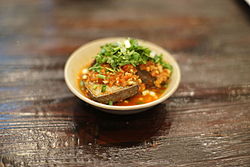Nutritional value
Fermented bean curd contains organic acids,alcohol,esters and other flavor primitives. It contains a large amount of hydrolyzed protein,free amino acids,fat,carbohydrates,thiamine,riboflavin,oxalic acid,calcium,phosphorus and other nutritional ingredients. It contains no cholesterol. The amount of protein in fermented tofu is about 12–22%. [6]
Ho et al. (1989) compared the volatile flavor compounds of red fermented bean curd and white fermented bean curd. Red fermented bean curd contains much larger amounts of alcohols,esters,and acids than the white variety. This may be due to the fermentation of red rice by Monascus spp. [7] The differences in nutritional properties and fermentation between the two varieties are accompanied by differences in flavor and color.
Health effects
The Food Encyclopedia,written by Wang Su-Hsiung (1861) of the Qing dynasty,made reference to preserved bean curd as superior to difficult-to-digest,hardened tofu especially for the elderly,children,and ill persons. [4] Fermented bean curd is reportedly easier to digest than unfermented bean curd,because it is made through the fermentation process of mold,making the protein more digestible,absorbable,and richer in vitamins. And the microorganisms decompose the phytic acid in the beans,making minerals such as iron and zinc,which are initially poorly absorbed in soybeans,more easily absorbed by the body. [8] So it may be easier for patients,elderly,or children to eat and absorb the nutrients. [9]
It has been suggested that fermented bean curd may have certain health benefits,although there is insufficient data to confirm these claims. One report claims that the fermentation process generates isoflavones,and that fermented bean curd could reduce the risk of coronary heart disease,lower blood pressure,and prevent osteoporosis. [10]






